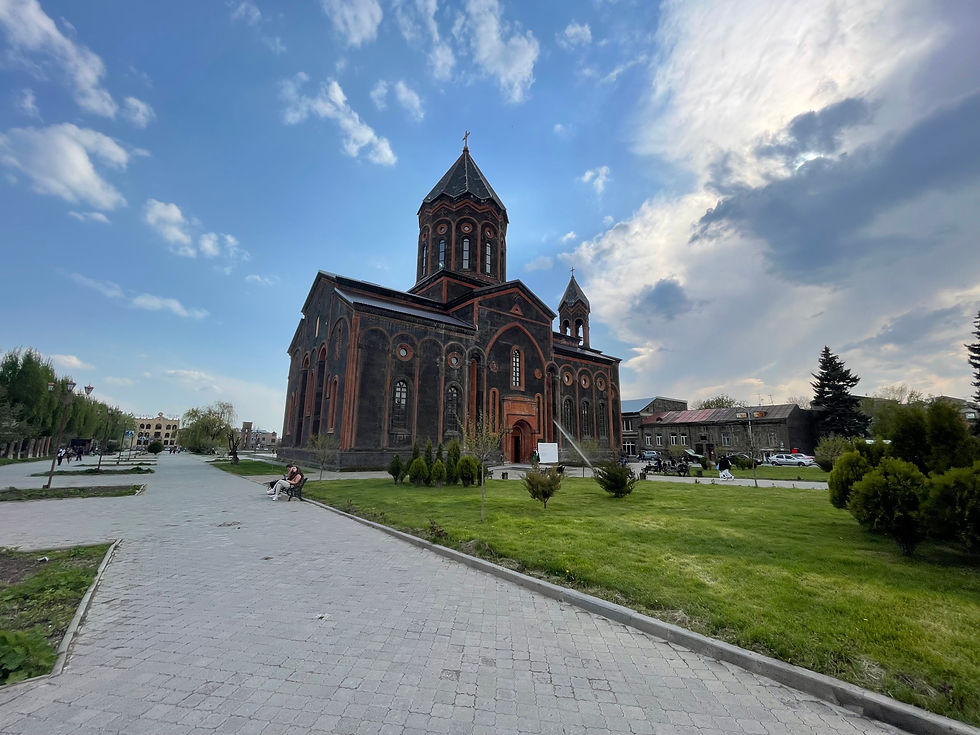
The city of Gyumri (also Gjumri) is the second largest city in Armenia and the capital of Shirak Province. It is located in the north-west of the country at an altitude of 1592 meters, near the Turkish border. Gyumri draws on a moving story. The distinctive features include the features of the former Soviet Union, from which Armenia gained independence in 1991, which can still be seen in the architecture today.
But an earthquake in 1988 left its mark on Gyumri and the surrounding villages. More than 50,000 people lost their lives. Ruins of residential houses, ditches in the middle of the land-scape and boulders from former buildings do not make you forget the magnitude of the earthquake.
Many countries participated in the reconstruction of the city. The influences are reflected in the architecture of the city and also in the naming of certain parts of the city. The Emili Aregak Center is right next to the so-called "Austrian village", which was built by Austrian helpers after the earthquake. The streets and houses are named after Austrian writers, musicians, politicians and also places. But not everything has been built up to date. There is a lack of paved roads, especially on the outskirts.
The center of Gyumri

We regularly take minibus lines 20 and 22 to the center of Gyumri and get off at Vartanants Square. This forms the city center. Two churches, the town hall as well as cafés and restaurants are located around the square. The Moscow cinema in the center shows films in Armenian and Russian - a relic of the former Soviet era. In addition to the Armenian mother tongue, the population also speaks excellent Russian. English is now also taught at school. But we also meet Armenians who speak a few words of German.

On Vartanants Square is the Saint All Saviors Church. It is 36 meters high and was built of black and red stone. The church was severely damaged during the 1988 earthquake. To date, it has not yet been completely restored. A stone memorial at the back marks the time the town and church were destroyed on December 7, 1988.
By the way: If you want to attend a holy mass in Armenia, you should take your time. Normal length is 2 to 3 hours. But don't worry - you are also welcome if you only attend the celebrations for a few minutes. 😉

At the opposite end of the square is the Cathedral of the Holy Mother of God. During the Soviet Union era, most of the country's churches were closed. But this Cathedral remained open. The two domes that fell during the earthquake are still located in front of the church. They were replaced by new ones.
Abovyan Street is a beautifully cobbled pedestrian street. In addition to cafés, bars and restaurants, it also offers small galleries and beautiful courtyards. There is also the Emili Aregak Bakery, which is definitely worth a visit.

Like in the capital Yerevan, the Statue of the Mother of Armenia can also be found in Gyumri on a hill on the outskirts of the city. She watches over the city and in 1975 replaced the statue of Stalin standing there.
Next to the statue of the Mother of Armenia is the Black Fortress. It was built in 1834. In the center is the Alexandropol Fortress with three gates. The southern and northern fortress served to defend Alexandropol. The city bore this name during the time of the Russian Empire. Underground passages lead from the black fortress to the Mother of Armenia.
Our first conclusion
Gyumri is a city of contrasts. The beautiful, small center with its black stone buildings, its beautifully paved streets and chic cafés invites you to stroll. On the outskirts, life looks a little different. Above-ground gas lines are just as much a part of the cityscape as unpaved roads and prefabricated buildings. But it is precisely these contrasts that make up the flair of the city and show the multifaceted nature of Armenia. We are already looking forward to new discoveries in this city, because it has much more to offer than what we have seen until now.














Comments